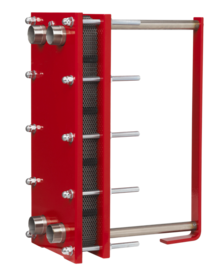Difference between revisions of "Heat Exchanger Courses"
(Created page with "Category:Courses, Training{{Knoppen}} <noinclude><!------------------------------------------------ * READ THIS FIRST * Only edit this page if you can improve the content....") |
|||
| (One intermediate revision by the same user not shown) | |||
| Line 1: | Line 1: | ||
[[Category:Courses, Training]]{{Knoppen}} | [[Category:Courses, Training]]{{Knoppen}} | ||
[[File:Heat exchanger5.png|thumb|right|Heat Exchanger]] | |||
[[Heat Exchangers]] are used to heat one fluid with a hotter fluid, to cool a fluid with a colder fluid, to condense a gaseous fluid with a colder fluid, or to boil a liquid with a hotter fluid. In '''Heat Exchanger Course''' you will learn about the basic construction of shell and tube and plate type heat exchangers and about counter flow, parallel flow, and cross flow patterns of flow. The heat transfer equation is introduced along with the log mean temperature difference and the overall heat transfer coefficient. The meaning of multi-pass and regenerative heat exchangers is covered and several common heat exchanger applications are discussed. | |||
* | |||
* | |||
* --- | ==Objectives== | ||
At the conclusion of this course, the student will: | |||
* Be familiar with the parts of or general construction of shell, tube, and plate type heat exchangers | |||
* Be able to differentiate among parallel flow, counter flow and cross flow heat exchangers | |||
* Be able to differentiate between single-pass and multi-pass heat exchangers | |||
* Be able to differentiate between regenerative and non-regenerative heat exchangers. | |||
* Know the meanings of the terms hotwell and condensate depression | |||
==Intended Audience== | |||
Primarily for mechanical, chemical, nuclear and industrial engineers, but would be of interest to any engineer wanting a review of heat exchanger basics. Someone completing this course will gain knowledge about the types and flow patterns of heat exchangers and about some of their applications. | |||
Latest revision as of 21:44, 3 February 2013
Heat Exchangers are used to heat one fluid with a hotter fluid, to cool a fluid with a colder fluid, to condense a gaseous fluid with a colder fluid, or to boil a liquid with a hotter fluid. In Heat Exchanger Course you will learn about the basic construction of shell and tube and plate type heat exchangers and about counter flow, parallel flow, and cross flow patterns of flow. The heat transfer equation is introduced along with the log mean temperature difference and the overall heat transfer coefficient. The meaning of multi-pass and regenerative heat exchangers is covered and several common heat exchanger applications are discussed.
Objectives
At the conclusion of this course, the student will:
- Be familiar with the parts of or general construction of shell, tube, and plate type heat exchangers
- Be able to differentiate among parallel flow, counter flow and cross flow heat exchangers
- Be able to differentiate between single-pass and multi-pass heat exchangers
- Be able to differentiate between regenerative and non-regenerative heat exchangers.
- Know the meanings of the terms hotwell and condensate depression
Intended Audience
Primarily for mechanical, chemical, nuclear and industrial engineers, but would be of interest to any engineer wanting a review of heat exchanger basics. Someone completing this course will gain knowledge about the types and flow patterns of heat exchangers and about some of their applications.
